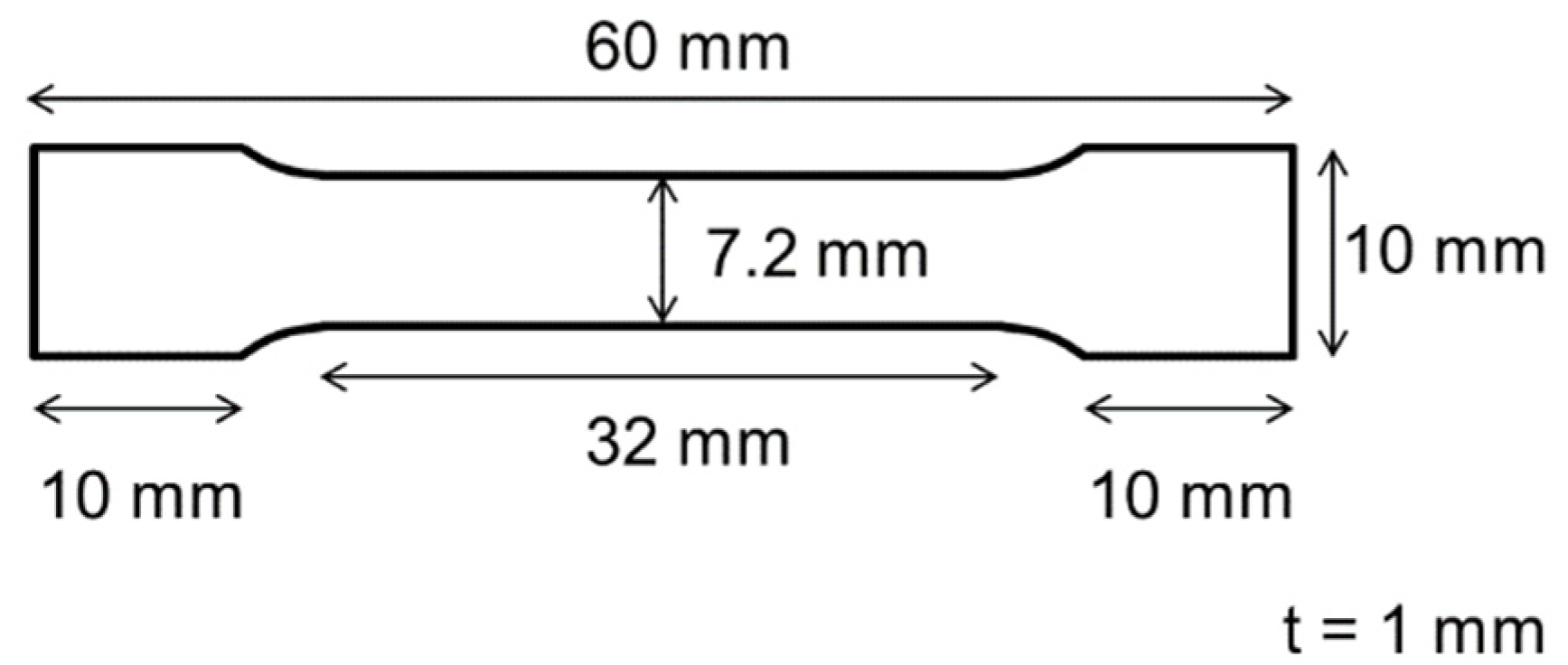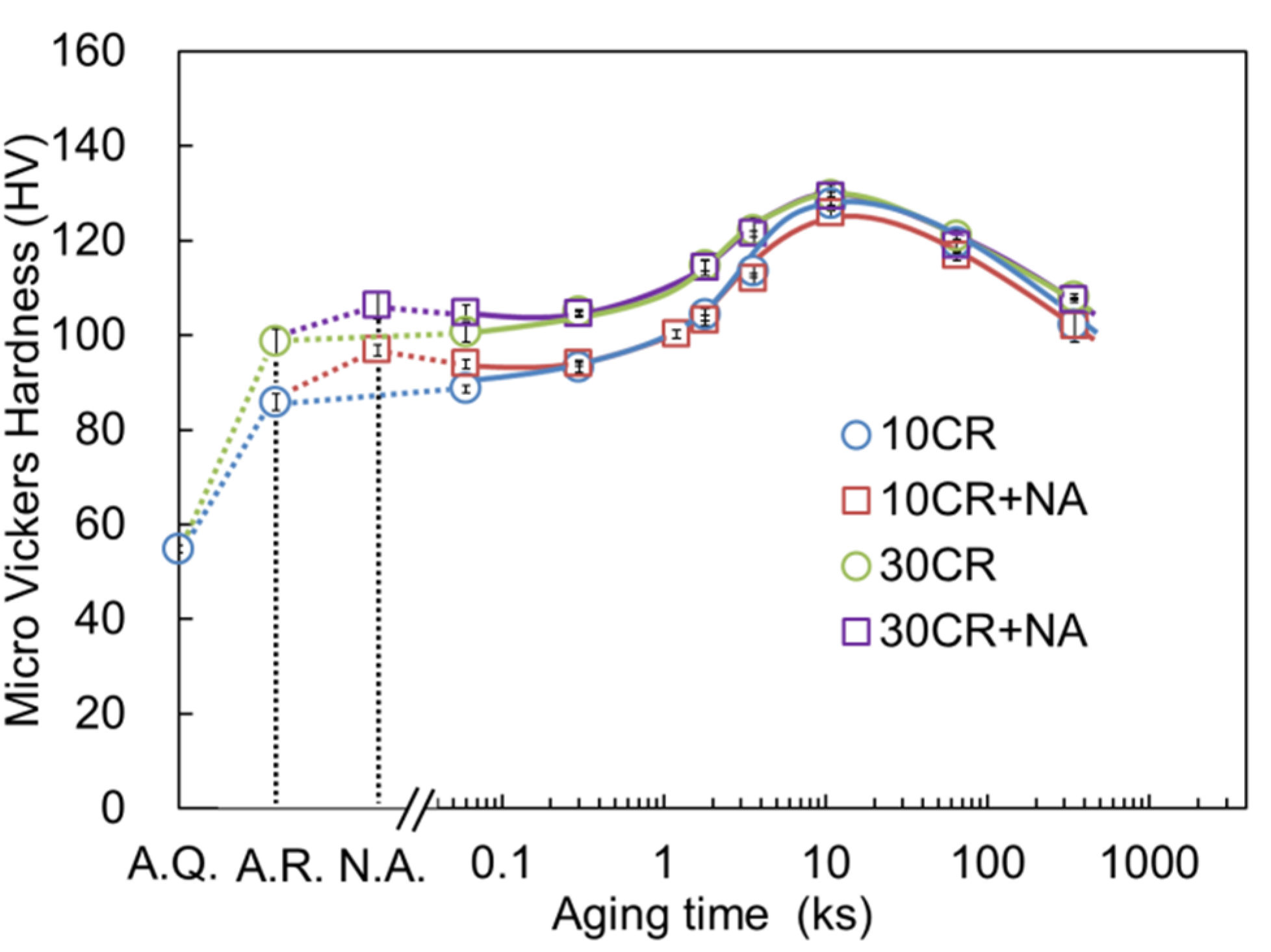Effect of Cold Rolling on Cluster(1) Dissolvability during Artificial Aging and Formability during Natural Aging in Al-0.6Mg-1.0Si-0.5Cu Alloy
Abstract
:1. Introduction
2. Experimental Procedure
3. Results and Discussion
4. Conclusions
Author Contributions
Funding
Institutional Review Board Statement
Informed Consent Statement
Data Availability Statement
Conflicts of Interest
References
- Sunde, J.K.; Marioara, C.D.; Holmestad, R. The effect of low Cu additions on precipitate crystal structures in overaged Al-Mg-Si(-Cu) alloys. Mater. Charact. 2019, 160, 110087. [Google Scholar] [CrossRef]
- Du, J.; Zhang, A.; Zhang, Y.; Wang, T.; Xiong, S.; Liu, F. Atomistic determination on stability, cluster and microstructures in terms of crystallographic and thermo-kinetic integration of Al−Mg−Si alloys. Mater. Today Commun. 2020, 24, 101220. [Google Scholar] [CrossRef]
- Yamada, K.; Sato, T.; Kamio, A. Cluster formation and two-step aging behaviors of Al-Mg-Si alloys. J. Jpn. Inst. Light Met. 2001, 51, 215–221. [Google Scholar] [CrossRef] [Green Version]
- Aruga, Y.; Kim, S.; Kozuka, M.; Kobayashi, E.; Sato, T. Effects of cluster characteristics on two-step aging behavior in Al-Mg-Si alloys with different Mg/Si ratios and natural aging periods. Mater. Sci. Eng. A 2018, 718, 371–376. [Google Scholar] [CrossRef]
- Serizawa, A.; Hirosawa, S.; Sato, T. Three-Dimensional Atom Probe Characterization of Nanoclusters Responsible for Multistep Aging Behavior of an Al-Mg-Si Alloy. Met. Mater. Trans. A 2008, 39, 243–251. [Google Scholar] [CrossRef]
- Masuda, T.; Takaki, Y.; Sakurai, T.; Hirosawa, S. Combined Effect of Pre-Straining and Pre-Aging on Bake-Hardening Behavior of an Al-0.6 mass%Mg-1.0 mass%Si Alloy. Mater. Trans. 2010, 51, 325–332. [Google Scholar] [CrossRef] [Green Version]
- Serizawa, A.; Sato, T.; Poole, W.J. The characterization of dislocation–nanocluster interactions in Al–Mg–Si(–Cu/Ag) alloys. Philos. Mag. Lett. 2010, 90, 279–287. [Google Scholar] [CrossRef]
- Serizawa, A.; Sato, T.; Miller, M. Effect of cold rolling on the formation and distribution of nanoclusters during pre-aging in an Al–Mg–Si alloy. Mater. Sci. Eng. A 2013, 561, 492–497. [Google Scholar] [CrossRef]
- Aruga, Y.; Kozuka, M.; Sato, T. Formulation of initial artificial age-hardening response in an Al-Mg-Si alloy based on the cluster classification using a high-detection-efficiency atom probe. J. Alloy. Compd. 2018, 739, 1115–1123. [Google Scholar] [CrossRef]
- Poznak, A.; Marceau, R.; Sanders, P. Composition dependent thermal stability and evolution of solute clusters in Al-Mg-Si analyzed using atom probe tomography. Mater. Sci. Eng. A 2018, 721, 47–60. [Google Scholar] [CrossRef]
- Zhu, S.; Shih, H.-C.; Cui, X.; Yu, C.-Y.; Ringer, S.P. Design of solute clustering during thermomechanical processing of AA6016 Al–Mg–Si alloy. Acta Mater. 2020, 203, 116455. [Google Scholar] [CrossRef]
- Kirekawa, K.; Kobayashi, J.; Ohnuma, M.; Kuramoto, S.; Itoh, G.; Kobayashi, E. Effect of 90% cold rolling on precipitation behavior of Al-0.6Mg-1.0Si-0.5Cu alloy. J. Jpn. Inst. Light Met. 2021, 71, 555–559. [Google Scholar]
- Thronsen, E.; Marioara, C.D.; Sunde, J.K.; Minakuchi, K.; Katsumi, T.; Erga, I.; Andersen, S.J.; Friis, J.; Marthinsen, K.; Matsuda, K.; et al. The effect of heavy deformation on the precipitation in an Al-1.3Cu-1.0Mg-0.4Si wt.% alloy. Mater. Des. 2019, 186, 108203. [Google Scholar] [CrossRef]
- Liu, M.; Wu, Z.; Yang, R.; Wei, J.; Yu, Y.; Skaret, P.C.; Roven, H.J. DSC analyses of static and dynamic precipitation of an Al–Mg–Si–Cu aluminum alloy. Prog. Nat. Sci. 2015, 25, 153–158. [Google Scholar] [CrossRef] [Green Version]
- Terada, D.; Kaneda, Y.; Horita, Z.; Matsuda, K.; Hirosawa, S.; Tsuji, N. Mechanical properties and microstructure of 6061 aluminum alloy severely deformed by ARB process and subsequently aged at low temperatures. IOP Conf. Ser. Mater. Sci. Eng. 2014, 63, 012088. [Google Scholar] [CrossRef]
- Cerri, E.; Leo, P. Influence of severe plastic deformation on aging of Al–Mg–Si alloys. Mater. Sci. Eng. A 2005, 410–411, 226–229. [Google Scholar] [CrossRef]
- Chrominski, W.; Wenner, S.; Marioara, C.D.; Holmestad, R.; Lewandowska, M. Strengthening mechanisms in ultrafine grained Al-Mg-Si alloy processed by hydrostatic extrusion—Influence of ageing temperature. Mater. Sci. Eng. A 2016, 669, 447–458. [Google Scholar] [CrossRef] [Green Version]
- Rao, P.N.; Singh, D.; Brokmeier, H.-G.; Jayaganthan, R. Effect of ageing on tensile behavior of ultrafine grained Al 6061 alloy. Mater. Sci. Eng. A 2015, 641, 391–401. [Google Scholar] [CrossRef]
- Yassar, R.S.; Field, D.; Weiland, H. The effect of predeformation on the β″ and β′ precipitates and the role of Q′ phase in an Al–Mg–Si alloy; AA6022. Scr. Mater. 2005, 53, 299–303. [Google Scholar] [CrossRef]
- Khangholi, S.N.; Javidani, M.; Maltais, A.; Chen, X.-G. Effects of natural aging and pre-aging on the strength and electrical conductivity in Al-Mg-Si AA6201 conductor alloys. Mater. Sci. Eng. A 2021, 820, 141538. [Google Scholar] [CrossRef]
- Mørtsell, E.A.; Marioara, C.D.; Andersen, S.J.; Røyset, J.; Reiso, O.; Holmestad, R. The Effect of Cu and Ge Additions on Strength and Precipitation in a lean 6xxx Aluminium Alloy. J. Phys. Conf. Ser. 2015, 644, 012028. [Google Scholar] [CrossRef]
- Sunde, J.K.; Lu, F.; Marioara, C.D.; Holmedal, B.; Holmestad, R. Linking mechanical properties to precipitate microstructure in three Al-Mg-Si(-Cu) alloys. Mater. Sci. Eng. A 2021, 807, 140862. [Google Scholar] [CrossRef]
- Saito, T.; Marioara, C.D.; Røyset, J.; Marthinsen, K.; Holmestad, R. The effects of quench rate and pre-deformation on precipitation hardening in Al–Mg–Si alloys with different Cu amounts. Mater. Sci. Eng. A 2014, 609, 72–79. [Google Scholar] [CrossRef] [Green Version]
- Saito, T.; Muraishi, S.; Marioara, C.D.; Andersen, S.J.; Røyset, J.; Holmestad, R. The Effects of Low Cu Additions and Predeformation on the Precipitation in a 6060 Al-Mg-Si Alloy. Met. Mater. Trans. A 2013, 44, 4124–4135. [Google Scholar] [CrossRef] [Green Version]
- Seyedrezai, H.; Grebennikov, D.; Mascher, P.; Zurob, H.S. Study of the early stages of clustering in Al–Mg–Si alloys using the electrical resistivity measurements. Mater. Sci. Eng. A 2009, 525, 186–191. [Google Scholar] [CrossRef]
- Deschamps, A.; Perez, M. Mesoscopic modelling of precipitation: A tool for extracting physical parameters of phase transformations in metallic alloys. Comptes Rendus Phys. 2010, 11, 236–244. [Google Scholar] [CrossRef]
- Shewmon, P. Diffusion in Solids, 2nd ed.; Springer International Publishers: Cham, Switzerland, 2016; pp. 191–205. [Google Scholar] [CrossRef]







| Sample | Peak Temperature [°C] |
|---|---|
| NA | 217.2 |
| 10CR + NA | 186.5 |
| 30CR + NA | 183.4 |
| Without AA | AA for 0.3 ks | |
|---|---|---|
| NA | 5.37 | 1.70 |
| 10CR + NA | 1.03 | 0.66 |
| 30CR + NA | 0.85 | - |
Publisher’s Note: MDPI stays neutral with regard to jurisdictional claims in published maps and institutional affiliations. |
© 2022 by the authors. Licensee MDPI, Basel, Switzerland. This article is an open access article distributed under the terms and conditions of the Creative Commons Attribution (CC BY) license (https://creativecommons.org/licenses/by/4.0/).
Share and Cite
Kirekawa, N.; Saito, K.; O, M.; Kobayashi, E. Effect of Cold Rolling on Cluster(1) Dissolvability during Artificial Aging and Formability during Natural Aging in Al-0.6Mg-1.0Si-0.5Cu Alloy. Metals 2022, 12, 92. https://doi.org/10.3390/met12010092
Kirekawa N, Saito K, O M, Kobayashi E. Effect of Cold Rolling on Cluster(1) Dissolvability during Artificial Aging and Formability during Natural Aging in Al-0.6Mg-1.0Si-0.5Cu Alloy. Metals. 2022; 12(1):92. https://doi.org/10.3390/met12010092
Chicago/Turabian StyleKirekawa, Naoto, Kaisei Saito, Minho O, and Equo Kobayashi. 2022. "Effect of Cold Rolling on Cluster(1) Dissolvability during Artificial Aging and Formability during Natural Aging in Al-0.6Mg-1.0Si-0.5Cu Alloy" Metals 12, no. 1: 92. https://doi.org/10.3390/met12010092






